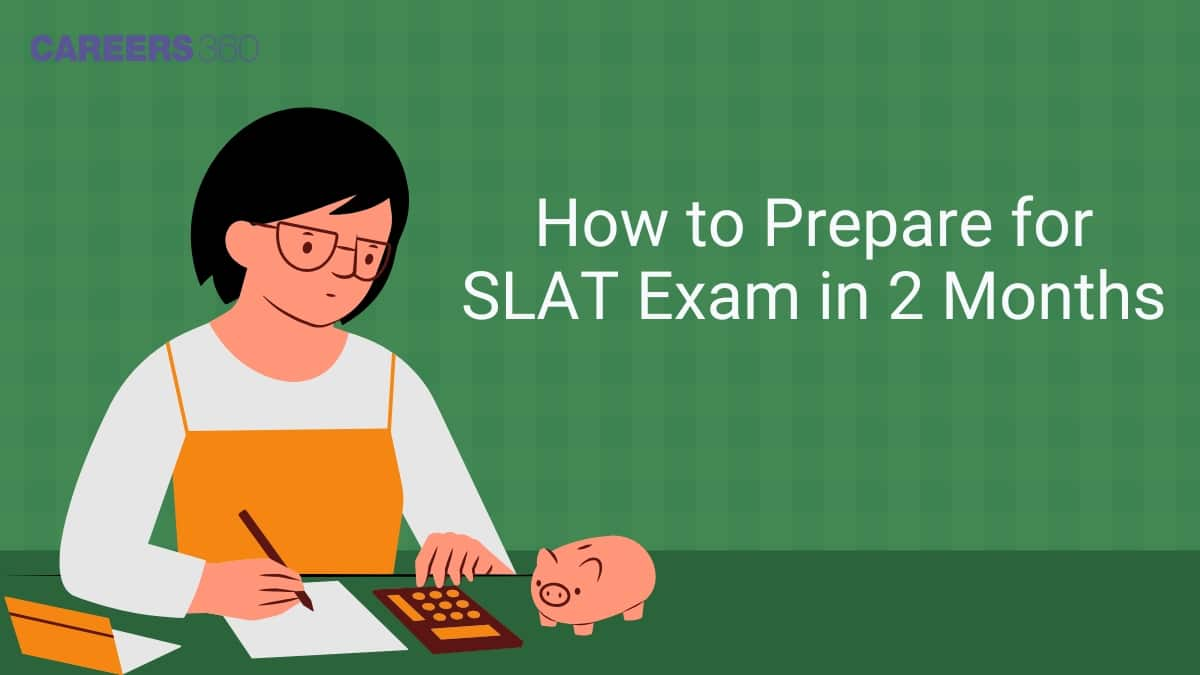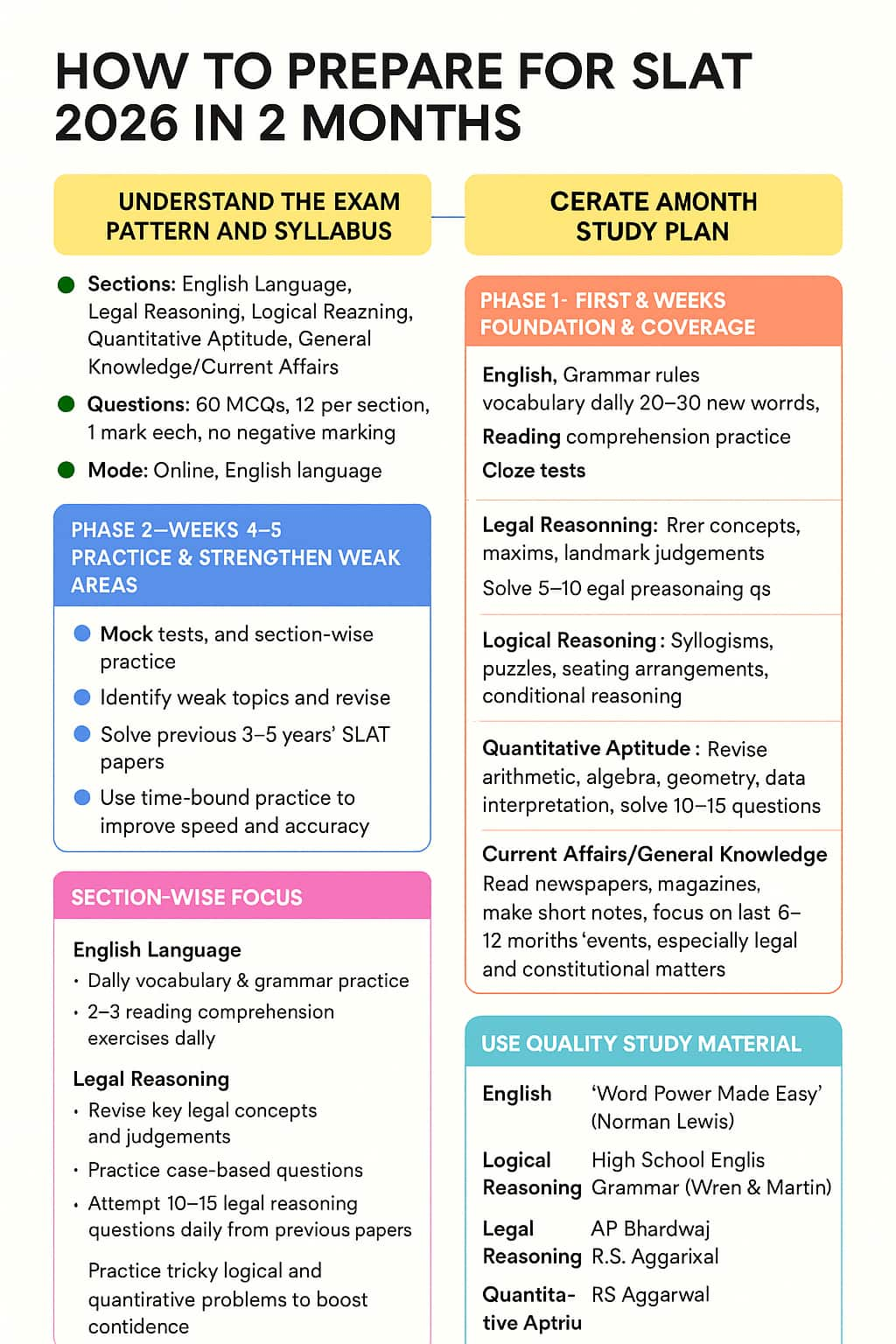UPES Integrated LLB Admissions 2026
Ranked #18 amongst Institutions in India by NIRF | Ranked #1 in India for Academic Reputation by QS Rankings | 16 LPA Highest CTC
SLAT Admit Card Date:11 Dec' 25 - 20 Dec' 25
How to Prepare for SLAT 2026 in 2 Months! The Symbiosis Law Admission Test (SLAT) is one of India’s premier law entrance exams, conducted annually for admission to Symbiosis Law Schools. Known for its competitive nature and challenging questions, the SLAT entrance exam requires strategic preparation to secure a high rank.

Most students start preparing for SLAT 2026 at least a year in advance due to the variety of topics and difficulty level. However, candidates who are quick learners and can grasp concepts efficiently can still perform well with a focused two-month preparation plan. In this guide, we will outline an effective 2-month strategy to prepare for SLAT 2026, including section-wise tips, practice methods, and time management techniques to maximise your score.
Cracking SLAT in just 2 months requires a disciplined, focused, and strategic approach. You need to cover the syllabus efficiently while maximising practice and revision. Here’s a step-by-step strategy:
Before diving in, spend 1–2 days thoroughly understanding the SLAT syllabus 2026 exam pattern and syllabus:
Sections: English Language, Legal Reasoning, Logical Reasoning, Quantitative Aptitude, General Knowledge/Current Affairs.
Questions: 60 MCQs, 12 per section, 1 mark each, no negative marking.
Mode: Online, English language.
Tip: Knowing the weightage and SLAT Exam Pattern 2026 helps allocate your time wisely.
Divide the preparation into three phases:
Phase | Duration | Focus Areas | Activities / Strategy |
Phase 1: Foundation & Coverage | Weeks 1–3 | All Sections | English: Grammar rules, vocabulary (20–30 new words daily), reading comprehension practice, and cloze tests. Legal Reasoning: Key concepts, maxims, landmark judgments; solve 5–10 questions daily. Logical Reasoning: Syllogisms, puzzles, seating arrangements, and conditional reasoning. Quantitative Aptitude: Revise arithmetic, algebra, geometry, data interpretation; solve 10–15 questions daily. Current Affairs/GK: Read newspapers/magazines; make short notes; focus on the last 6–12 months, especially legal & constitutional matters. |
Phase 2: Practice & Strengthen Weak Areas | Weeks 4–5 | Section-wise Practice | Focus on mock tests and sectional practice. Identify weak topics and revise them. Solve the previous 3–5 years’ SLAT papers. Use time-bound practice to improve speed and accuracy. |
Phase 3: Intensive Revision & Mock Tests | Weeks 6–8 | Revision & Exam Readiness | Take full-length mock tests every alternate day; analyze mistakes. Revise formulas, vocabulary, and legal principles. Daily revision of short notes for GK, current affairs, legal facts. Practice tricky logical and quantitative problems to boost confidence. |
English Language
Daily vocabulary & grammar practice.
2–3 reading comprehension exercises daily.
Solve cloze and para-jumble exercises.
Logical Reasoning
Solve puzzles and reasoning sets regularly.
Work on deduction, assumptions, and argument strengthening/weakening questions.
Quantitative Aptitude
Focus on speed and shortcuts.
Revise formulas & practice mental calculations.
Solve mixed-topic sets to simulate exam conditions.
General Knowledge/Current Affairs
Maintain short notes for quick revision.
Focus on legal, constitutional, and major current events.
Take 2–3 online quizzes daily.
English: “Word Power Made Easy” (Norman Lewis), “High School English Grammar” (Wren & Martin).
Logical Reasoning: RS Agarwal, Jain Prateek.
Legal Reasoning: AP Bhardwaj, R.S. Aggarwal.
Quantitative Aptitude: RS Agarwal.
Current Affairs: Newspapers, Manorama Yearbook, Arihant Current Affairs Yearly.
Start mocks from Week 3 onwards.
Analyse mistakes carefully and revise areas that need improvement
Practice SLAT Previous Year Papers.
Take time-bound mock tests to improve speed and accuracy.
Download SLAT 2026: 10 Free Mock Tests PDF ( Answers with Detailed Solution).
Divide time wisely across sections during practice.
Attempt easier sections first during mocks to build confidence.
Practice solving questions within 1 minute per question.
Use the last 1–2 weeks for revision only.
Revise notes, vocabulary, formulas, and key legal concepts.
Solve at least 2 full-length mock tests per week in the final week.
Stay calm and maintain a growth mindset – confidence is as important as preparation.
Start with concepts and basics, then practice extensively.
Prioritize weak areas but maintain overall balance.
Regular mock tests are crucial for time management and confidence.
Revision is non-negotiable – use short notes effectively.
Stay motivated, disciplined, and consistent.

To effectively attempt SLAT (Symbiosis Law Admission Test) 2026 questions, it's important to have a well-thought-out strategy. Here are some tips to help you maximize your score:
1. Understand the Exam Pattern:
Familiarize yourself with the SLAT exam pattern, which typically includes sections on Logical Reasoning, Legal Reasoning, Analytical Reasoning, Reading Comprehension, and General Knowledge. Understanding the weightage of each section will help you allocate your time effectively.
2. Prioritize Your Strengths:
Start with sections where you feel most confident. This will help build momentum and boost your confidence as you progress through the paper.
3. Time Management:
Divide your time according to the number of questions and the difficulty level of each section. For example, you might allocate more time to sections that require more thought, such as Legal Reasoning or Analytical Reasoning.
4. Read Questions Carefully:
Ensure you understand what each question is asking. Misreading a question can lead to incorrect answers, especially in sections like Logical Reasoning and Reading Comprehension.
5. Use the Process of Elimination:
For multiple-choice questions, eliminate obviously incorrect answers first. This increases your chances of choosing the correct answer from the remaining options.
6. Stay Calm and Focused:
It’s natural to feel anxious during the exam, but staying calm is crucial. If you encounter a difficult question, move on and return to it later if time permits.
7. Guess Wisely:
If you're unsure about an answer and there's no negative marking, make an educated guess. If there's a negative marking, only guess if you can eliminate some options and are reasonably sure.
8. Legal Reasoning Approach:
In the Legal Reasoning section, focus on applying the principles given in the question to the facts presented. Avoid letting your personal knowledge of the law influence your answers.
9. Practice Mock Tests:
Regular practice with mock tests will help you get used to the exam format and improve your speed and accuracy. Analyze your performance in each mock to identify areas of improvement.
10. Review Your Answers:
If time permits, review your answers, especially for sections that require precise answers, like Logical and Analytical Reasoning. This can help catch any careless mistakes.
Among top 100 Universities Globally in the Times Higher Education (THE) Interdisciplinary Science Rankings 2026
Integrated Learning – A balanced blend of management and legal education
Ranked #18 amongst Institutions in India by NIRF | Ranked #1 in India for Academic Reputation by QS Rankings | 16 LPA Highest CTC
Last Date to Apply: 21st December 2025 | Grade 'A+' accredited by NAAC | Ranked 33rd by NIRF 2025
Approved by BCI | Continuous interaction with leading experts from the industry | Global Exposure
Admissions open for B.A. LL.B. (Hons.), B.B.A. LL.B. (Hons.) and LL.B Program (3 Years) | School of Law, MRU ranked No. 1 in Law Schools of Excellence in India by GHRDC (2023)